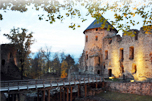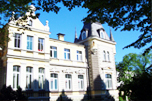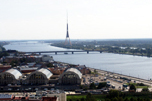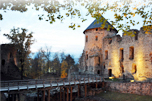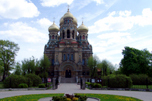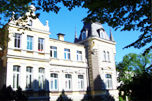The Tibetan race is found not only in the Tibet Autonomous Region, but also in the four provinces of Qinghai, Gansu, Sichuan and Yunnan. No matter where they are located, they believe death means the beginning of a new round of life. Preoccupied by this belief, they show respect to the dead and bury them according to local customs and habits.
In the areas inhabited by the Tibetans, burial ways vary with social status of the deceased. Top treatment goes to stupa burial, followed by cremation and celestial burial which is the most popular with the Tibetans.
Under ancient influence, some follow the cave, building, platform, indoor, tree and other forms of burials rarely seen in the world.
In some localities, burial in the ground dominate but dead children follow the burial in water.
Following are special burial habits of the Tibetans.
BURIAL IN CAVES. This form of burial is found mainly in the Tibetan area in Beima, Gansu Province. In this part of the world, the dead is bathed and put on new clothes before being tied into the squatting or sitting stances. When all these are done, they are left in a pit. The pit is sealed with a wooden plant and covered with dirt.
COFFIN BURIAL. This is popular with the Tibetans in Zhouqu, Gansu Province. For the couple, one who dies first is contained in a coffin. And the coffin is left by the cliff, cropfield and crossroad without being buried underneath. Generally, there is a huge rock on the coffin for fear that the dead would be attacked by wild animals. When the other of the couple is dead, he/she would be left in the same coffin with his/her spouse and buried in the ground. This is designed to make the couple inseparable during their next life.
BUILDING BURIAL. This is also called household burial popular with the Tibetans in Kangnan. The dead is buried at the corner of the top floor of the house. However, the dead has to be one much revered, a prestigious lama, one who enjoyed long life, one who had five generations in the family, and one who dares to hold justice.
PLATFORM BURIAL. This is popular with Tibetans in Batang, Kangnan. Stones are used to make a platform measuring one meter wide and one meter high. The dead is tied into the shape of a foetus, and put into a wooden box on the stone platform. When all these are done, numerous pieces of stone are used to cover the box.
INDOOR BURIAL. This is popular with Tibetans in Kangbei. It is suitable for one who lived 80 years or longer. The dead is tied into a dough, with the eyes, ears, nostrils and mouths stuffed with butter, gold, silver or gems. The body is left in a wooden box or huge jar, which is stuffed with highland barley ears and other cereals. The box or jar is then sealed for cremation 10 years later. Ashes thus produced are poured into the river or buried in the ground. As such a burial takes a decade, it is also called duel burial.
TREE BURIAL. This is popular with Tibetans in Nyingchi and Kangbei, and applied mainly to the dead infants. The body is cleaned with salt water before left in a wooden box, wooden basket or bamboo basket. It is hung halfway up a tree or a branch. Though the Tibetans in the above-mention area believe it would help prevent the repetition of the family misfortune, it is not common as children do not die from time to time.
RED-HAND BURIAL. When a less-than-two-month-old baby dies, its hands are painted red. The body is tied into the shape of foetus and contained in a back basket. The basket containing the dead baby is tied with two large pieces of rock and buried by the river. When the river rises, the body is carried away. Down the river is usually placed with a stone slab inscribed with sutra lines and worshipped with butter lamps and Mani poles.
